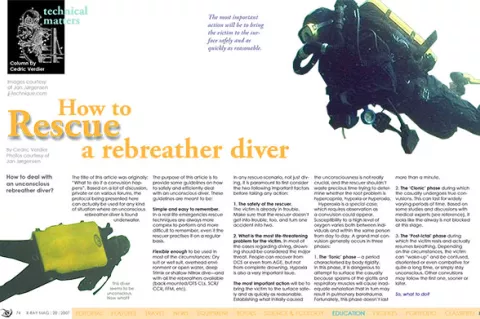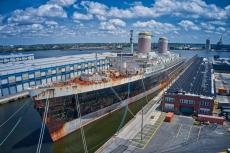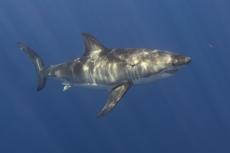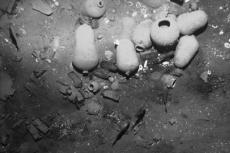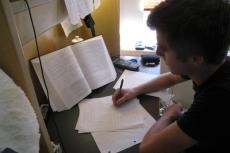How to deal with an unconscious rebreather diver?
The title of this article was originally: “What to do if a convulsion happens”. Based on a lot of discussion, private or on various forums, the protocol being presented here can actually be used for any kind of situation where an unconscious rebreather diver is found underwater.
The purpose of this article is to provide some guidelines on how to safely and efficiently deal with an unconscious diver. These guidelines are meant to be:
Simple and easy to remember. In a real life emergencies rescue techniques are always more complex to perform and more difficult to remember, even if the rescuer practises it on a regular basis.
Flexible enough to be used in most of the circumstances: Dry suit or wet suit, overhead environment or open water, deep Trimix or shallow Nitrox dive—and with all the rebreathers available (back-mounted/OTS CLs, SCR/CCR, FFM, etc).
In any rescue-scenario, not just diving, it is paramount to first consider the two following important factors before taking any action:
- The safety of the rescuer.
The victim is already in trouble. Make sure that the rescuer doesn’t get into trouble, too, and turn one accident into two.
- What is the most life-threatening problem for the victim. In most of the cases regarding diving, drowning should be considered the major threat. People can recover from DCS or even from AGE, but not from complete drowning. Hypoxia is also a very important issue.
The most important action will be to bring the victim to the surface safely and as quickly as reasonable. Establishing what initially caused the unconsciousness is not really crucial, and the rescuer shouldn’t waste precious time trying to determine whether the root problem is hypercapnia, hypoxia or hyperoxia.
Hyperoxia is a special case, which requires observation as a convulsion could appear. Susceptibility to a high level of oxygen varies both between individuals and within the same person from day to day. A grand mal convulsion generally occurs in three phases:
- The ‘Tonic’ phase – a period characterised by body rigidity. In this phase, it is dangerous to attempt to surface the casualty because spasms of the glottis and respiratory muscles will cause inadequate exhalation that in turn may result in pulmonary barotrauma. Fortunately, this phase doesn’t last more than a minute.
- The ‘Clonic’ phase during which the casualty undergoes true convulsions. This can last for widely varying periods of time. Based on some studies and discussions with medical experts (see reference), it looks like the airway is not blocked at this stage.
- The ‘Post-Ictal’ phase during which the victim rests and actually resumes breathing. Depending on the circumstances, the victim can “wake-up” and be confused, disoriented or even combative for quite a long time, or simply stay unconscious. Other convulsions may follow the first one, sooner or later.
So, what to do?
Step 1: Stabilize the victim in the water column.
If the diver is found unconscious close to the bottom, find a stable position on the bottom or a shot line. If the diver is found unconscious in mid-water or during deco, try to maintain the depth by catching the ascent line.
If the rescuer can attract attention and get some help, a second diver can be very handy to assist the rescuer in doing the following:
● In open water, to send up an emergency SMB to alert the surface support team
● In a cave, to aid going through restrictions or simply to take care of the navigation
● At the surface, to help removing the victim’s gear and to provide first aid
● In general, to control buoyancy on the bottom and during the ascent
Step 2: Assess the situation
The rescuer has to assess the victim, the equipment and the environment in order to determine the best course of action, and if the ascent has to be immediate or slightly delayed. In any case, this assessment should be quick and shouldn’t delay the rescue, but make it more efficient. The rescuer has to deal with a high level of stress as time is crucial.
Assessing the victim
Is it an oxygen toxicity seizure?
In case of a convulsion underwater, the dangerous part being the Tonic phase that doesn’t last very long, the diver’s depth has only to be kept constant at the very beginning (a few seconds up to one minute). If drowning is the major concern (as it should be if the rebreather diver does not wear a FFM or a neckstrap that efficiently protects their airway), the main priority is to bring the victim as soon as safely possible.
Is the victim breathing?
If there is no obvious sign of breathing (no bubble, no chest movement, no movement of the counterlungs), it is of the utmost importance to bring the victim to surface to administer artificial respiration/CPR.
Assessing the equipment
Does the diver wear a full face mask or a neckstrap that efficiently protects the airway? If it is not the case, even if the diver still has the mouthpiece in place, drowning is a major concern and any delay in the ascent should be avoided.
Is the mouthpiece still in the mouth? If not, do not attempt to replace it but ensure that the mouthpiece is switched to the surface position. Try to seal the mouth and ascend immediately.
Note: Opening the mouth to put in a regulator might only achieve water introduction/drowning. Some rescuers feel confident in attempting to seal a second stage with a breathable mix against the lips in the hope that if breathing resumes air will be inspired instead of water. None of these actions should delay the ascent or compromise the efficiency of the rescue.
Is there any water in the mask?
A partially or completely flooded mask could be a major problem for the victim’s airway. If it is the case, try to pinch the nose during the ascent.
Is the loop content safe to breathe? This is only a concern if the diver breathes, and the airway is protected. The rescuer can check the pO2 readings to make sure that the victim will be able to breathe a safe mix during the ascent.
Hypoxia: It is crucial to check the loop content, as the pO2 will drop when ascending to the shallows.
Hyperoxia: Flushing the loop with diluent or switching to an integrated OC second stage (BOV) could be an option to consider. (Remember that breathing a high O2 content in the loop could also be beneficial on a decompression standpoint).
In case of Mixed-gas diving, the Open Circuit mix has to be breathable all the way up to the surface, and the amount of gas in the tank has to be sufficient (and the valve open).
Hypercapnia: Without a proper scrubber monitor, it will be difficult for the rescuer to assess the CO2 level in the loop, and it’s not a major issue anyway. A diluent flush will help in any case, as it could also help in case of a partial loop flood.
Note: To efficiently flush the loop on most of the units, the rescuer has to open the over-pressure valve first.
Assessing the environment
Is there any physical problem that could delay the ascent?
A strong current could make the rescuer consider swimming to an ascent line rather than drifting far from the boat. An overhead environment (cave, ice, wreck penetration) could delay the ascent as the rescuer will have to swim to the exit point.
Is there any physiological concern that could delay the ascent?
If a breathing victim with a properly protected airway (Full face mask, neck strap) has a significant decompression obligation, the rescuer has to consider the possibility of performing the required stops to minimize the risks of DCS.
If the victim does not breathe or does not have a properly protected airway, the ascent to the surface should be immediate. Nevertheless, the rescuer could have a significant decompression obligation as well.
In this case, three main options are available:
- Ascending with the victim at the surface, provide first aid or hand over the victim to the surface support, then eventually follow a missed deco procedure.
- Handing the victim over to another diver with no/less decompression obligation.
- Sending the victim to the surface on their own, hoping that the surface support will be efficient and fast enough
Note: This is a personal decision, based on a lot of factors that have to be quickly considered by a highly stressed rescuer:
● The apparent state of the victim (not breathing for a very long time, etc.)
● The amount of decompression obligation and the perceived risk of DCS
● The accepted risk (that could depend on the relationship with the victim)
● The efficiency and the availability of the surface support
● The surface condition (rough sea where the victim will not be seen, etc)
Step 3: Ascending to the surface
Opening the airway
Ensure that the victim’s airway is open by keeping the neck slightly extended.
Controlling the ascent
It is often very difficult to keep control of the buoyancy of two divers at the same time, particularly in the shallows:
● Slowly inflate the victim’s BC to start ascending.
● Open the victim’s loop OPV (and the dry suit purge if appropriate).
● Control the victim’s BCD purge.
● Control the rescuer’s own buoyancy.
Note: In case of a malfunctioning unit (leaking solenoid, ADV, manual injector, BCD inflator, etc), it may be difficult for the rescuer to quickly find out if there is a leak, where it comes from and how to stop it. The rescuer has to be aware that the rescue could end up in an uncontrolled ascent.
Establishing positive buoyancy at the surface
If the loop is not flooded, simply fully inflate the victim’s BC should provide enough buoyancy to maintain the diver at the surface. Make sure that the DSV is closed when removed from the mouth. Depending on the equipment or if the loop is flooded, it may be necessary to release some weight or accessories (canister light, sling tank, etc).
Step 4: Providing first aid
This means first care for the victim and the rescuer:
● Call for help. If no help is available, it may be necessary for the rescuer to stop for a few seconds to keep the stress level reasonable and assess the victim and the resources available at the surface.
● Ensure the victim is breathing or initiate artificial ventilation (as taught in all the basic Rescue Diver courses).
● Hand over the victim to the surface support or swim to the nearest platform available (boat, shore, etc) in order to provide better care (CPR/first aid/O2).
● Arrange for evacuation (nearest chamber/ diving physician).
● The rescuer may perform missed deco procedures if appropriate (without delaying evacuation). ■




